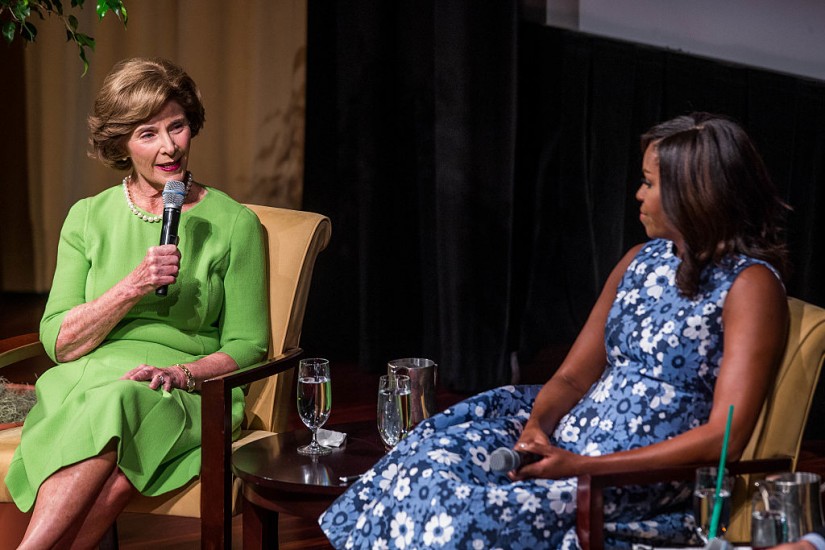President Trump has caved under massive pressure and issued an executive order that will allow for the detention of migrant children with their parents instead of separating families. One of the key moments in pressuring Trump to act came when the usually nonpolitical former first lady, Laura Bush, wrote an editorial condemning the Trump administration’s policy. Bush not only rose above party lines and offered a compassionate argument about human rights, she also unwittingly tapped into a covert way of mobilizing activists that began over a century-and-a-half ago.
Bush did not use the terms “illegal immigrant” or even “refugee” in her article; instead, she wrote about “children” and “parents.” In so doing, she shifted the hotly polemical debates surrounding immigration into the disarming, utterly familiar language of the family. Former first lady Michelle Obama responded to Bush’s article by tweeting, “Sometimes truth transcends party.”
That former first ladies, rather than former presidents, are speaking out matters. Their language, as well as their formal positions as wives and mothers, draw upon a strategy that has been in use since before the Civil War: women using their maternal roles to make the moral case against policies that separate families.
Some leading women writers deployed this strategy in the decade before the Civil War. In their efforts to end slavery, abolitionists in the 1850s described children being ripped apart from their mothers, an act so immoral that it moved previously disengaged people to take a stand against slavery.
In the antebellum period, abolitionists’ main opponents were not proslavery advocates but, instead, apathetic Northerners. They understood that the real barrier to ending slavery was not just a handful of policymakers and pundits but the millions of Americans who could easily ignore the issue.
Harriet Beecher Stowe, author of “Uncle Tom’s Cabin,” attempted to stir Northern women’s emotions by creating a character, Eliza, who risked having her child torn from her side — a choice that exposed slavery as a violation of motherhood.
The story was a heart-wrenching one. In the novel, Eliza overhears her master’s plan to sell her son, Harry, to a faraway plantation. To avoid losing her child, Eliza escapes with her son in the middle of the night. When her owner discovers she is missing, he gives chase with a team of men and bloodhounds. They eventually discover her near the banks of the frozen Ohio River — the physical divide between slavery and freedom. Unwilling to be separated from her son, she leaps onto floating cakes of ice, becomes dizzy and slips. The men scream after her. As Stowe described, “her stockings cut from her feet — while blood marked every step; but she saw nothing, felt nothing, till dimly, as in a dream, she saw the Ohio side.”
Eliza and her son eventually make it to freedom.
During an era when the proslavery press painted a picture of enslaved women as monstrous, promiscuous and incapable of genuine human thought and emotion, Stowe presented Eliza as a mother who, in a powerful act of heroic love, fought her way across a frozen river to remain with her child.
The separation of mother and child became a recurring theme in abolitionist books. In her 1861 autobiography “Incidents in the Life of a Slave Girl,” Harriet Jacobs, a fugitive slave who escaped to the North and wrote under the pseudonym Linda Brent, described her separation from her children. Throughout the book, she addressed her Northern women readers, explaining how New Year’s Day “comes laden with peculiar sorrows” for slave mothers, because it is the day when slaves were hired out to other masters. Jacobs described the restless nights before the hiring out, when the enslaved mother “sits on her cold cabin floor, watching the children who may be torn from her the next morning; and often she does wish that she and they might die before the day dawns.”
These stories of mothers and children being separated, woven through many books of the era, spurred women across the North to become politically engaged. Though not yet enfranchised, these white women joined the abolitionist movement in record numbers. They created groups like the Rochester Ladies Anti-Slavery Society before the war and continued to support black mothers after the war by establishing a number of Freedmen’s Aid Societies.
Women became the foot soldiers of one of the largest protest movements in the 19th century because of the ways in which the bonds of motherhood exposed the evil of slavery. These stories transformed the political, legal and economic details of the institution of slavery into a familiar language of the family. They also revealed the humanity of slaves and put an end to the longtime proslavery argument that enslavement benefited people of African descent.
Family remained a deeply politicized topic long after slavery ended. From debates over the role that the dissolution of the black family played in producing poverty, to the ideal of a nuclear family residing in idyllic suburbs, to the rise of “family values” in conservative politics, the family remained one of the central political issues throughout the 20th century and into the 21st. Oftentimes, it was female activists driving the debates.
Yet women activists have been most persuasive when they avoid using the language of the family as a political tool and instead show how policies damage or separate families. Long before Laura Bush arrived in the White House and later used her platform as a former first lady to condemn children being separated from their parents, white and black women abolitionists first put pen to paper to ensure “No Child Left Behind.”
